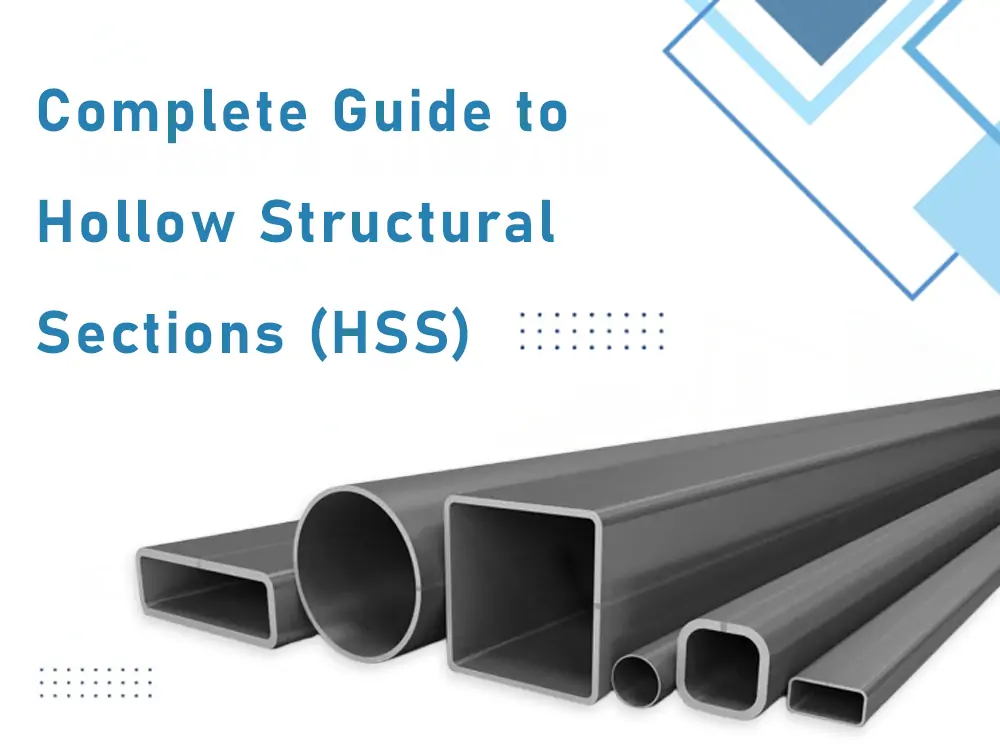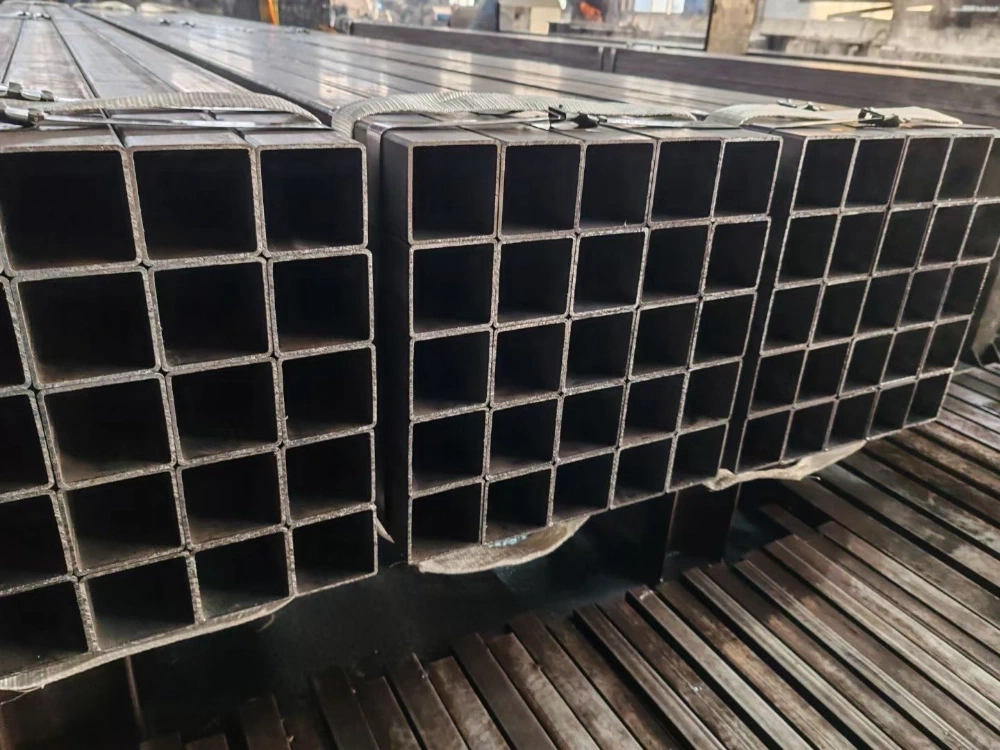
Tubes d'acier à section creuse (HSS) sont des tubes en acier de construction présentant une résistance élevée à la traction et des applications porteuses. Il existe trois grands types de tubes en acier HSS : circulaires, rectangulaires et carrés. Les tubes en acier HSS sont essentiels dans les applications structurelles en raison de leur rapport résistance/poids élevé. Ils sont largement utilisés dans les projets d'infrastructure, les installations industrielles et les travaux de construction. Dans ce guide, nous aborderons les aspects les plus importants des tubes en acier inoxydable. Il vous donnera une idée complète de la manière dont les tubes HSS peuvent contribuer à votre projet.
Qu'est-ce qu'un tube en acier HSS ?
Le tube d'acier à section creuse est une catégorie de tube d'acier de construction. Par rapport aux tubes d'acier entiers, ils ont une section transversale creuse. Selon les différentes applications, les tubes d'acier HSS sont de forme ronde, carrée ou rectangulaire. Les tubes en acier HSS sont principalement fabriqués en acier au carbone conformément à la spécification ASTM A500. On trouve également des tubes conformes aux normes A1085 et A1065. En raison de leur section creuse, les tubes HSS présentent un rapport résistance/poids très élevé. L'acier au carbone A500 est durable et polyvalent, ce qui fait que les tubes en acier HSS conviennent à diverses applications industrielles.
Types de tubes en acier HSS
La section transversale circulaire assure une distribution équilibrée de la pression. Les tubes circulaires en acier HSS sont idéaux pour les composants structurels tels que les poutres et les échafaudages. Comme les tubes de forme ronde ont la plus grande surface, ils offrent la plus grande résistance à la flexion pour le même matériau.
Les tubes en acier HSS à section rectangulaire et carrée sont utilisés exclusivement pour des applications structurelles. Les bords droits facilitent l'empilage des tubes les uns à côté des autres. Ils sont également plus faciles à raccorder bout à bout par soudage. Ils offrent une grande modularité, mais leur flexibilité sous contrainte est moindre.
Grades HSS courants
ASTM A500
La plupart des tubes en acier inoxydable dont l'épaisseur de paroi est supérieure à 0,12 sont fabriqués selon les normes de l'Union européenne. Grade ASTM A500. C'est l'une des qualités d'acier de construction les plus populaires et les plus fiables. Il existe deux sous-catégories, les nuances B et C. La nuance B contient 0,26% de carbone, soit un peu plus que la nuance C (0,23%). La nuance C, en revanche, contient 1,351 TTP3T de manganèse, ce qui n'est pas le cas de la nuance B. La composition des autres métaux dans les deux nuances reste la même. Les tubes HSS conformes à la norme A500 sont fabriqués par formage à froid et soudage. Ils présentent d'excellentes propriétés de résistance à la traction et à la charge.
A1085
Les tubes en acier HSS conformes à la norme ASTM A1085 se présentent sous forme carrée, rectangulaire et ronde. La norme A1085 est une autre nuance d'acier au carbone à haute résistance et faible concentration d'alliage. Elle offre des limites de tolérance plus étroites que la norme ASTM A500, ce qui la rend essentielle pour une construction précise. La norme A1085 est brillante pour les applications lourdes, elle est utilisée dans les bâtiments, les piliers, les grues et les plates-formes off-shore.
EN10210
EN10210 est une nuance d'acier standard européenne. Il s'agit d'un acier fini à chaud principalement utilisé pour les tubes en acier HSS. Il convient parfaitement aux applications nécessitant un acier de construction à grain fin et non allié. Les tubes en acier HSS relevant de la norme EN10210 peuvent être façonnés en formes carrées, rectangulaires ou rondes.

Applications des tubes d'acier à profil creux (HSS)
Éléments structurels et machines
La résistance et la variabilité de conception des tubes en acier HSS profitent grandement aux applications de construction. Vous pouvez compter sur les tubes en acier HSS pour les colonnes de fondation, les piliers et les échafaudages. Les éléments de conception utilisant des tubes exposés sont courants. Les composants d'équipements lourds tels que les cadres, les supports et les béquilles sont également des cas d'utilisation populaires.
Équipement industriel
Les machines de l'industrie lourde utilisent des tubes en acier HSS pour leur résistance à la traction et à la pression. Ils composent les cylindres hydrauliques, les corps de machines, les piliers de soutien, etc.
Pétrole et gaz
Les tubes en acier HSS sont utilisés sur les plates-formes pétrolières à terre et en mer. Ils sont également utilisés pour les supports d'outils robustes, les équipements de forage, la construction de plates-formes et d'autres applications.
Avantages de la section structurale creuse
Les principaux avantages des tubes en acier HSS sont leur rapport résistance/poids élevé, leur robustesse, leur durabilité et leur variabilité. Ils sont utilisés dans des secteurs tels que la construction, la fabrication et l'architecture. Par rapport aux sections en acier massif, ils sont considérablement plus légers. Avec un revêtement anticorrosion approprié, ils offrent une durée de vie aussi longue que les autres composants en acier massif.
Limites de la section structurale creuse
Malgré les nombreux avantages des tubes en acier HSS, il est nécessaire de connaître leurs lacunes. Les tubes en acier HSS ont un coût plus élevé par tonne. Cela est dû à leur processus de fabrication coûteux. La disponibilité des dimensions des tubes HSS est limitée par rapport aux poutres en L standard. Dans certains cas, en raison de l'épaisseur limitée des parois, des renforts supplémentaires peuvent être nécessaires pour assurer l'intégrité structurelle.
Comparaison des tubes en acier HSS avec d'autres matériaux
Par rapport à d'autres aciers comme l'ASTM A53, les tubes en acier HSS offrent un rapport résistance/poids supérieur. L'acier en forme de tube standard ne répond pas à des spécifications rigoureuses et est principalement destiné au transport de fluides. Les tubes en acier inoxydable, en revanche, sont destinés à des applications structurelles lourdes. Ils sont rentables et polyvalents. Les tubes en acier HSS sont des outils précieux pour l'architecture, la construction et les applications industrielles.
Conclusion
Les tubes d'acier à section structurale creuse sont des éléments de construction inestimables dans plusieurs secteurs. Ils constituent un choix populaire parmi les architectes, les constructeurs et les fabricants. En tant que composant structurel, ils sont solides, durables et légers. En outre, ils ont plusieurs applications esthétiques dans la conception intérieure et extérieure. Il est important de noter que sur le plan structurel, les profilés HSS ne sont pas différents de l'acier tubulaire. Toutefois, grâce aux conditions de fabrication rigoureuses exigées par l'ASTM, les tubes en acier inoxydable sont devenus l'un des meilleurs éléments de construction.
